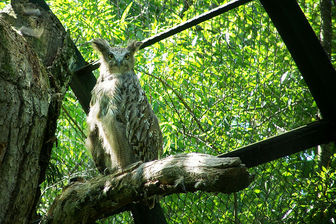Blakiston's Fish-Owl
It feeds on a variety of aquatic prey, including fish and amphibians, but also takes small mammals and birds to the size of hazel grouse . It also takes carrion, as evidenced by fish owls in Russia being trapped in snares set for furbearing mammals, which use raw meat as bait.

Original source: MIKIPermission(Reusing this file)This image, which was originally posted to Flickr.com, was uploaded to Commons using Flickr upload bot on 22:20, 25 June 2009 (UTC) by Snowmanradio (talk). On that date it was licensed under the license below.This file is licensed under the Creative Commons Attribution 2.0 Generic license.You are free:to share – to copy, distribute and transmit the work
Author: MIKIPermission(Reusing this file)This image, which was originally posted to Flickr.com, was uploaded to Commons using Flickr upload bot on 22:20, 25 June 2009 (UTC) by Snowmanradio (talk). On that date it was licensed under the license below.This file is licensed under the Creative Commons Attribution 2.0 Generic license.You are free:to share – to copy, distribute and transmit the work
The Blakiston's Fish-Owl is classified as Endangered (EN), considered to be facing a very high risk of extinction in the wild.
Photo: Blakiston's Fish-owlBlakiston's fish-owl (Ketupa blakistoni) is a charismatic, endangered owl associated with old-growth riparian forests in northeast Asia. Approximately 1,000 pairs of these massive birds are thought to persist in the wild, with very few represented in zoos. Little is known about the Blakiston’s fish-owl in mainland Russia due to the elusive nature of the species and difficulties associated with collecting data in this remote region. More
The Blakiston's Fish-owl is the largest and most endangered species in the owl family. The Blakiston's Fish-owl is in a pinch now because both the woods and fish that it feeds on are disappearing. Size & Weight (Adult) Body length: 71cm Wingspan: 190cm Weight: 3.4-4. More
Family : Strigidae
Genus : Ketupa
Species : blakistoni
Authority : (Seebohm, 1884)

